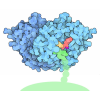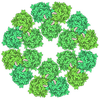+ Open data
Open data
- Basic information
Basic information
| Entry | Database: PDB / ID: 7au2 | |||||||||||||||||||||||||||
|---|---|---|---|---|---|---|---|---|---|---|---|---|---|---|---|---|---|---|---|---|---|---|---|---|---|---|---|---|
| Title | Cryo-EM structure of human exostosin-like 3 (EXTL3) | |||||||||||||||||||||||||||
 Components Components | Exostosin-like 3 | |||||||||||||||||||||||||||
 Keywords Keywords | TRANSFERASE / glycosyltransferase / heparan / n-acetylglucosaminyltransferase | |||||||||||||||||||||||||||
| Function / homology |  Function and homology information Function and homology informationglucuronosyl-galactosyl-proteoglycan 4-alpha-N-acetylglucosaminyltransferase / glucuronyl-galactosyl-proteoglycan 4-alpha-N-acetylglucosaminyltransferase activity / positive regulation of detection of glucose / protein-hormone receptor activity / positive regulation of keratinocyte proliferation / negative regulation of keratinocyte differentiation / heparan sulfate proteoglycan biosynthetic process / negative regulation of inflammatory response to wounding / XBP1(S) activates chaperone genes / : ...glucuronosyl-galactosyl-proteoglycan 4-alpha-N-acetylglucosaminyltransferase / glucuronyl-galactosyl-proteoglycan 4-alpha-N-acetylglucosaminyltransferase activity / positive regulation of detection of glucose / protein-hormone receptor activity / positive regulation of keratinocyte proliferation / negative regulation of keratinocyte differentiation / heparan sulfate proteoglycan biosynthetic process / negative regulation of inflammatory response to wounding / XBP1(S) activates chaperone genes / : / glycosyltransferase activity / negative regulation of cytokine production involved in inflammatory response / negative regulation of inflammatory response / positive regulation of cell growth / positive regulation of phosphatidylinositol 3-kinase/protein kinase B signal transduction / endoplasmic reticulum membrane / magnesium ion binding / endoplasmic reticulum / Golgi apparatus / nucleus / plasma membrane Similarity search - Function | |||||||||||||||||||||||||||
| Biological species |  Homo sapiens (human) Homo sapiens (human) | |||||||||||||||||||||||||||
| Method | ELECTRON MICROSCOPY / single particle reconstruction / cryo EM / Resolution: 2.43 Å | |||||||||||||||||||||||||||
 Authors Authors | Wilson, L.F.L. / Dendooven, T. / Hardwick, S.W. / Chirgadze, D.Y. / Luisi, B.F. / Logan, D.T. / Mani, K. / Dupree, P. | |||||||||||||||||||||||||||
| Funding support |  United Kingdom, United Kingdom,  Sweden, 8items Sweden, 8items
| |||||||||||||||||||||||||||
 Citation Citation |  Journal: Nat Commun / Year: 2022 Journal: Nat Commun / Year: 2022Title: The structure of EXTL3 helps to explain the different roles of bi-domain exostosins in heparan sulfate synthesis. Authors: L F L Wilson / T Dendooven / S W Hardwick / A Echevarría-Poza / T Tryfona / K B R M Krogh / D Y Chirgadze / B F Luisi / D T Logan / K Mani / P Dupree /     Abstract: Heparan sulfate is a highly modified O-linked glycan that performs diverse physiological roles in animal tissues. Though quickly modified, it is initially synthesised as a polysaccharide of ...Heparan sulfate is a highly modified O-linked glycan that performs diverse physiological roles in animal tissues. Though quickly modified, it is initially synthesised as a polysaccharide of alternating β-D-glucuronosyl and N-acetyl-α-D-glucosaminyl residues by exostosins. These enzymes generally possess two glycosyltransferase domains (GT47 and GT64)-each thought to add one type of monosaccharide unit to the backbone. Although previous structures of murine exostosin-like 2 (EXTL2) provide insight into the GT64 domain, the rest of the bi-domain architecture is yet to be characterised; hence, how the two domains co-operate is unknown. Here, we report the structure of human exostosin-like 3 (EXTL3) in apo and UDP-bound forms. We explain the ineffectiveness of EXTL3's GT47 domain to transfer β-D-glucuronosyl units, and we observe that, in general, the bi-domain architecture would preclude a processive mechanism of backbone extension. We therefore propose that heparan sulfate backbone polymerisation occurs by a simple dissociative mechanism. | |||||||||||||||||||||||||||
| History |
|
- Structure visualization
Structure visualization
| Structure viewer | Molecule:  Molmil Molmil Jmol/JSmol Jmol/JSmol |
|---|
- Downloads & links
Downloads & links
- Download
Download
| PDBx/mmCIF format |  7au2.cif.gz 7au2.cif.gz | 264.2 KB | Display |  PDBx/mmCIF format PDBx/mmCIF format |
|---|---|---|---|---|
| PDB format |  pdb7au2.ent.gz pdb7au2.ent.gz | 204.8 KB | Display |  PDB format PDB format |
| PDBx/mmJSON format |  7au2.json.gz 7au2.json.gz | Tree view |  PDBx/mmJSON format PDBx/mmJSON format | |
| Others |  Other downloads Other downloads |
-Validation report
| Summary document |  7au2_validation.pdf.gz 7au2_validation.pdf.gz | 1.2 MB | Display |  wwPDB validaton report wwPDB validaton report |
|---|---|---|---|---|
| Full document |  7au2_full_validation.pdf.gz 7au2_full_validation.pdf.gz | 1.2 MB | Display | |
| Data in XML |  7au2_validation.xml.gz 7au2_validation.xml.gz | 46.6 KB | Display | |
| Data in CIF |  7au2_validation.cif.gz 7au2_validation.cif.gz | 71.7 KB | Display | |
| Arichive directory |  https://data.pdbj.org/pub/pdb/validation_reports/au/7au2 https://data.pdbj.org/pub/pdb/validation_reports/au/7au2 ftp://data.pdbj.org/pub/pdb/validation_reports/au/7au2 ftp://data.pdbj.org/pub/pdb/validation_reports/au/7au2 | HTTPS FTP |
-Related structure data
| Related structure data |  11923MC  7auaC M: map data used to model this data C: citing same article ( |
|---|---|
| Similar structure data | Similarity search - Function & homology  F&H Search F&H Search |
- Links
Links
- Assembly
Assembly
| Deposited unit | 
|
|---|---|
| 1 |
|
- Components
Components
| #1: Protein | Mass: 101705.117 Da / Num. of mol.: 2 Source method: isolated from a genetically manipulated source Source: (gene. exp.)  Homo sapiens (human) / Gene: EXTL3, EXTL1L, EXTR1, KIAA0519 / Cell line (production host): HEK-293 EBNA / Production host: Homo sapiens (human) / Gene: EXTL3, EXTL1L, EXTR1, KIAA0519 / Cell line (production host): HEK-293 EBNA / Production host:  Homo sapiens (human) Homo sapiens (human)References: UniProt: O43909, glucuronosyl-galactosyl-proteoglycan 4-alpha-N-acetylglucosaminyltransferase #2: Polysaccharide | Source method: isolated from a genetically manipulated source #3: Polysaccharide | Source method: isolated from a genetically manipulated source Has ligand of interest | N | Has protein modification | Y | |
|---|
-Experimental details
-Experiment
| Experiment | Method: ELECTRON MICROSCOPY |
|---|---|
| EM experiment | Aggregation state: PARTICLE / 3D reconstruction method: single particle reconstruction |
- Sample preparation
Sample preparation
| Component | Name: Homodimer of EXTL3 globular domain / Type: COMPLEX / Entity ID: #1 / Source: RECOMBINANT |
|---|---|
| Molecular weight | Value: 0.17 MDa / Experimental value: NO |
| Source (natural) | Organism:  Homo sapiens (human) Homo sapiens (human) |
| Source (recombinant) | Organism:  Homo sapiens (human) Homo sapiens (human) |
| Buffer solution | pH: 7.5 |
| Specimen | Embedding applied: NO / Shadowing applied: NO / Staining applied: NO / Vitrification applied: YES |
| Specimen support | Grid material: COPPER / Grid type: Quantifoil |
| Vitrification | Instrument: FEI VITROBOT MARK IV / Cryogen name: ETHANE |
- Electron microscopy imaging
Electron microscopy imaging
| Experimental equipment |  Model: Titan Krios / Image courtesy: FEI Company |
|---|---|
| Microscopy | Model: TFS KRIOS |
| Electron gun | Electron source:  FIELD EMISSION GUN / Accelerating voltage: 300 kV / Illumination mode: SPOT SCAN FIELD EMISSION GUN / Accelerating voltage: 300 kV / Illumination mode: SPOT SCAN |
| Electron lens | Mode: BRIGHT FIELD |
| Image recording | Electron dose: 71.4 e/Å2 / Detector mode: INTEGRATING / Film or detector model: FEI FALCON III (4k x 4k) |
- Processing
Processing
| Software | Name: PHENIX / Version: 1.18.2_3874: / Classification: refinement | ||||||||||||||||||||||||||||||||||||||||
|---|---|---|---|---|---|---|---|---|---|---|---|---|---|---|---|---|---|---|---|---|---|---|---|---|---|---|---|---|---|---|---|---|---|---|---|---|---|---|---|---|---|
| EM software |
| ||||||||||||||||||||||||||||||||||||||||
| CTF correction | Type: PHASE FLIPPING AND AMPLITUDE CORRECTION | ||||||||||||||||||||||||||||||||||||||||
| Particle selection | Num. of particles selected: 656292 | ||||||||||||||||||||||||||||||||||||||||
| 3D reconstruction | Resolution: 2.43 Å / Resolution method: FSC 0.143 CUT-OFF / Num. of particles: 171285 / Symmetry type: POINT | ||||||||||||||||||||||||||||||||||||||||
| Atomic model building | Protocol: AB INITIO MODEL | ||||||||||||||||||||||||||||||||||||||||
| Refine LS restraints |
|
 Movie
Movie Controller
Controller




 PDBj
PDBj

